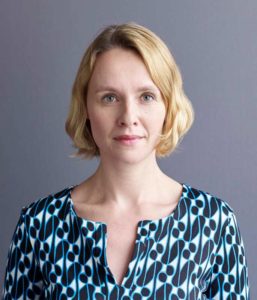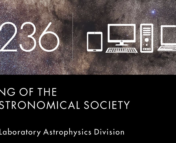In this series of posts, we sit down with a few of the keynote speakers of the 236th AAS meeting to learn more about them and their research. You can see a full schedule of their talks here, and read our other interviews here!
At this year’s AAS meeting, Jo Dunkley will be telling us about the future of cosmic microwave background observations and trying to answer the big questions such as whether the standard model for cosmology is correct.

Uncertain beginnings
Dunkley always loved doing maths at school but never thought of herself as a scientist, recalling “I had these perceptions of what a scientist would be and I thought that’s not really me”. Dunkley didn’t start her path through academia with her current position in mind. In her first year of University, she thought she “wasn’t good enough to do physics” and had the feeling that everyone around her was super smart. But what eventually got her through that first year was realising that everyone was finding it hard. She loved studying but wasn’t sure how that would ever translate to becoming a job. After a small break, she embarked on a PhD with the idea that this could potentially lead to a career in science communication due to her love of communicating and working with people, but ended up falling in love with research.
CMB observations beyond Planck
Now a professor at Princeton University, Dunkley is currently working on the next stage of cosmic microwave background (CMB) observations. Her talk at this year’s AAS will be discussing the new experiments and observations from the Atacama Cosmology Telescope in Chile, along with the new Simons Observatory that they’re currently building on the same site. The primary purpose of these observations is for Cosmology, but as a bonus, mapping half of the millimetre sky at arcminute resolution gives us other interesting astrophysical observations, such as AGN and our own galaxy. A big transition being made is having all the data publicly available and usable through codes, Jupyter notebooks and online tutorials. “The success of these experiments will only be partly in the science that we do from them but more so in the number of people that use the data.”
One of the main cosmological questions that interests Dunkley is whether our current standard cosmological model, ΛCDM, is correct. She comments “this model works really well”, and Dunkley is using this new cosmological data to constrain the parameters of ΛCDM, but also to test if this model is actually correct and to “push on the unanswered questions” such as what are cold dark matter and dark energy, and what made the initial conditions of our Universe in the first place.
Challenging the Standard Model of Cosmology
Whilst ΛCDM performs well as a model, there is reason to doubt it. The rate of growth of the Universe is characterised by the Hubble constant, originally measured by Edwin Hubble in the 1920s by looking at how fast galaxies are moving away from us. This method has since been updated by including more accurate distance measurements. However, the measure of the expansion of the Universe given by this method is much faster than the measurement by the CMB measured by the Planck satellite when assuming the ΛCDM model. To try and make sense of these contrasting results, Dunkley and collaborators are using these new measurements from Chile to first check if their results agree with Planck. They also want to see if there are any hints of new physics which could bring the measurements from these different methods into agreement.
Analysing all of this new data of course requires large numbers of people, and one of Dunkley’s favourite things about this stage of her career is being able to work with the people in her group. She loves that they can do things that she can’t. “I’m awed looking around the people I work with and all the different things they bring in”. When starting as a staff member, not doing everything herself and giving out tasks was quite a challenge and quite overwhelming, but Dunkley recognises that as a group they can do far more than she would be able to do alone and sees many benefits. One downside however is not having so much time to do her own research, such as sitting down and writing computer code which is one of the things she fell in love with at the beginning of her PhD.
Mentorship and Support
Since the start of her research career, Dunkley has benefitted from the wisdom of incredible mentors. As well as being fundamental to intellectual growth, she stresses how important they are for personal growth and support as well. One piece of advice she gives to those choosing a supervisor is to figure out how supportive they are and how much they’re willing to help you as a person. She thinks the field could do more in terms of general awareness of issues faced by those at the earlier stages of their career and also making sure junior scientists have a broad range of support.
Reflecting back on being a graduate student, Dunkley remembers a common feeling amongst colleagues without permanent positions: a concerning dissonance between whether they can “make it” and the knowledge that there simply aren’t enough faculty positions for everyone to succeed. Dunkley always tried to keep in her mind that there was always the possibility to do something different. Her goal was never necessarily to become a professor, but instead to keep pursuing what she was enjoying, with the knowledge that her skills were also applicable to many other career paths outside of academia. Not having such a strong commitment to staying in academia helped her to cope with the pressure of not knowing what the next step would be.
A balanced life
As well as being a successful professor working in large collaborations with people all over the world, Dunkley is also a mother to two children. She comments, “It’s not negotiable. If I had to choose between my kids and my career, I’d choose my kids.” This attitude reflects an unfortunate reality for many women who are leaving academia due to the difficulties of having children whilst maintaining a successful career in academia. “We do need some more adjustments in terms of allowances for reduced productivity and time off, particularly at the postdoc stage, we don’t have good enough procedures to say this person is going to have written less papers in these few years because you just have less time. It’s not because you’re less clever or less creative, it’s just less time.” Dunkley comments on how important it is for women to “value themselves”, stating that “even if you’ll be working less for an amount of time while kids are young, you’re still a valuable member of academia”. She recognises that there has to be a shift in mentality within the field so that it “just becomes normal” to have children and an academic career. “If we lost all the people from our field who want to also have children and then couldn’t, that would be a disaster.”
Hear Jo Dunkley’s talk about the future of CMB observations at her AAS Plenary talk ‘The Atacama Cosmology Telescope and the Simons Observatory: The Millimeter-Wave Sky from Chile’ at 4:30pm on Tuesday, June 2nd at #AAS236


